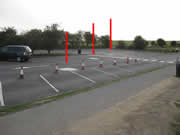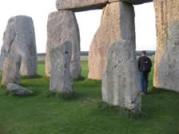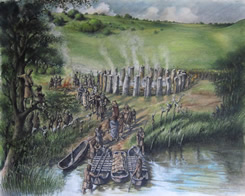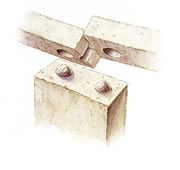







Stonehenge is a multiphased monument ie built in stages over a long period of time. It was built between 3000 and 2000 BC, but is part of a much larger ceremonial landscape which dates back somewhere up to 10,500 years ago. The earliest monuments in the landscape are marked by 3 small white discs on the tarmac at the lower end of the car-park. Chances are you will drive over them if you visit! The white discs mark where wooden postholes stood during the early mesolithic - the hunter gatherers - at least 3,500 years before the first phase of Stonehenge.Later features which predate Stonehenge that can still be seen are the Cursus and barrows or burial mounds. You will need more time or to go on a specialist tour to see these features.
by 3 small white discs on the tarmac at the lower end of the car-park. Chances are you will drive over them if you visit! The white discs mark where wooden postholes stood during the early mesolithic - the hunter gatherers - at least 3,500 years before the first phase of Stonehenge.Later features which predate Stonehenge that can still be seen are the Cursus and barrows or burial mounds. You will need more time or to go on a specialist tour to see these features.
Though people had been meeting and using the landscape for some considerable time beforehand, the first phase of Stonehenge dates to between 3000 and 2920 BC with the creation of a ditch with internal bank. The bank has the appearance of a '...string of sausages' and may have been upto 2m high though it is now much eroded.The dating of this part of the monument is believed to be fairly accurate because of the large amount of good dating evidence from antler and bone found in the ditch. After that the date for every other stage of Stonehenge is somewhat tenuous and subject to great debate.
At the moment the theory is that from its beginnings to around 2600 BC there was a timber phase at Stonehenge. This included 56 timber posts just inside the bank and the post holes were later filled with cremated human remains and now known as Aubrey holes.In 2008 Aubrey hole 7 was opened by the Stonehenge Riverside Project and it looks more like a hole for a stone rather than timber. It may be that stones were here from the start rather than later. The results from the most recent dig are due out in 2011 so we may have the 3rd major rewrite of the Stonehenge story within 20 years!
This included 56 timber posts just inside the bank and the post holes were later filled with cremated human remains and now known as Aubrey holes.In 2008 Aubrey hole 7 was opened by the Stonehenge Riverside Project and it looks more like a hole for a stone rather than timber. It may be that stones were here from the start rather than later. The results from the most recent dig are due out in 2011 so we may have the 3rd major rewrite of the Stonehenge story within 20 years!
Current dating assumptions suggest the first stones to arrive were the 'bluestones' from the Preseli Hills in west Wales.  Bluestone is a generic term for several types of volcanic rocks and each of them at Stonehenge weighs 4 - 6 tons.They are the ones that stand about man height as one looks into the stones. They don't look blue until dressed (ie shaped) and the outer covering of the stone removed.You can how blue on a tour out of hours to the inner circle.
Bluestone is a generic term for several types of volcanic rocks and each of them at Stonehenge weighs 4 - 6 tons.They are the ones that stand about man height as one looks into the stones. They don't look blue until dressed (ie shaped) and the outer covering of the stone removed.You can how blue on a tour out of hours to the inner circle.
The bluestones were originally set in double concentric arcs with the open end facing the south/southwest. When removed they were filled are now known as Q & R holes.
 In its final layout there are estimated to be 79 or 80 bluestones. An exciting discovery in September 2009 at the end of the Avenue where it meets the River Avon was a series of stone holes possibly holding bluestones. This 'Bluestone' henge may have held 24 stones. If the 56 Aubrey holes held stone rather than timbers it may be that there were two separate monuments that became united as the finishing phase of Stonehenge.
In its final layout there are estimated to be 79 or 80 bluestones. An exciting discovery in September 2009 at the end of the Avenue where it meets the River Avon was a series of stone holes possibly holding bluestones. This 'Bluestone' henge may have held 24 stones. If the 56 Aubrey holes held stone rather than timbers it may be that there were two separate monuments that became united as the finishing phase of Stonehenge.
Around 2400 BC sees the arrival from 19 miles to the north of 75 sarsen stones. A very hard form of silicified sandstone it lies on or just below the ground surface. A circle of 30 uprights were erected in the outer circle each weighing around 25 tonnes. These were topped with 30 lintels each weighing 6 - 7 tonnes.  The lintels don't rely on gravity to keep them in place they have mortice & tenon, and tongue & groove joints that we would normally find in a wood setting, but in stone. Each of the lintels also has some shaping on the inner and outer circular face to produce not far off a perfect circle.
The lintels don't rely on gravity to keep them in place they have mortice & tenon, and tongue & groove joints that we would normally find in a wood setting, but in stone. Each of the lintels also has some shaping on the inner and outer circular face to produce not far off a perfect circle.
The 5 trilithons (tri=3, lithon=stone) stand like a set of croquet hoops arranged in a horshoe shape in the centre of the circle. They step up in height as they go from the outer two to the remains of the Great Trilithon in the centre. Only 3 of the 5 trilithons still stand.
Around 2000BC the bluestones were re-erected. The altar stone was placed in the circle. Some realignments of external stones took place.
Hundreds if not thousands of theories abound. A temple to the sun? Meeting place for the chiefdons? Healing place for the sick? ? Astronomical observatory? A necropolis? Certainly. There are probably more than a tousand burials in the immediate area. Druidic temple? Probably not. They were a later 'priesthood' and the neo druids are an 18th century invention.Whatever it is it's probably more about winter solstice sunset after which the days get lighter and warmer, rather than the more popularly attended summer solstice sunrise. A mystery?. Certainly.
align="center">
Page last updated: Wednesday, April 29, 2015